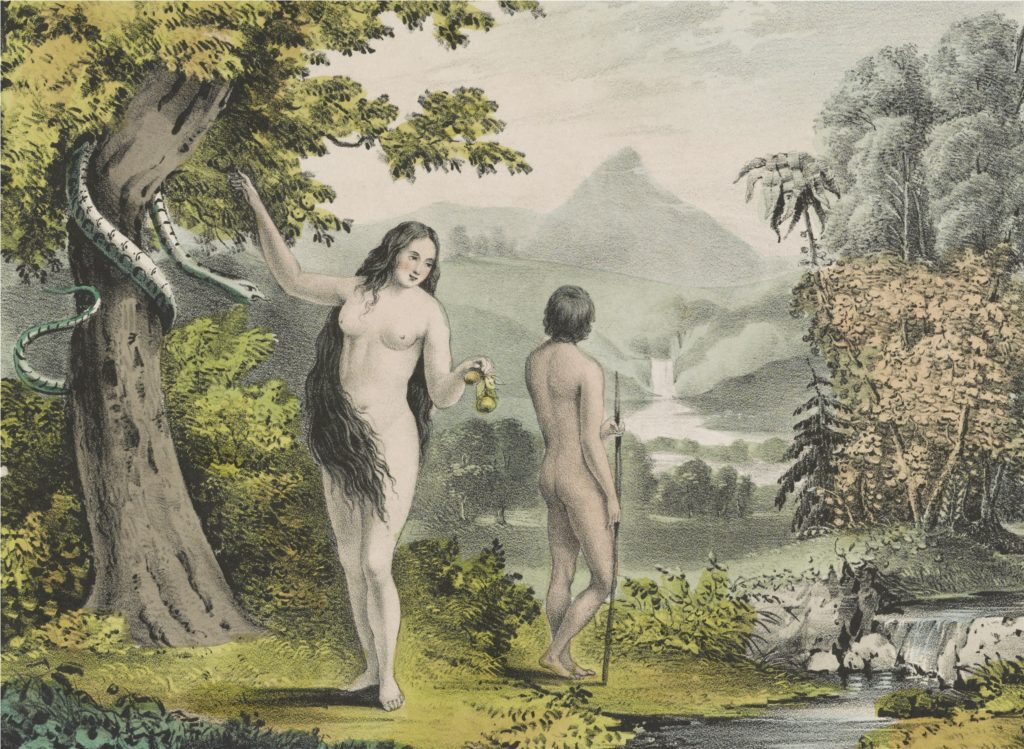Labor Pains and Helpless Infants: Eve or Evolution? (Part 1)
Before Eve ate from the Tree of Knowledge and shared it with Adam, being human was apparently hunky-dory. However, after Earth’s first two people disobeyed their creator, He cast them out of The Garden and plagued their descendants with Original Sin. Now, if humans aren’t breaking our backs in the fields or at computers, we’re laboring during childbirth. Plus, our babies, which are punishingly difficult to bear, are unbearably needy for the beginning of their existence. It’s all there in Genesis and its interpretation: difficult childbirth and helpless infants—these hallmarks of humanity—are thanks to Eve.
But there’s another explanation for these hallmarks of our species. It’s an idea that’s known in anthropological circles as the obstetrical dilemma (OD), and it goes something like this: Natural selection has favored our large brains. Natural selection has also favored limited pelvic dimensions that are conducive to walking and running upright. Thus, the fit between baby and birth canal is tight and can’t be relieved by making the pelvis any roomier. As a consequence, childbirth is difficult, and as a solution to the dilemma, babies are born earlier in their development so that they can escape alive before they outgrow the unforgiving gateway inside their mother.
Aside from being an elegant and satisfying idea, the hypothesis comes as a relief to many of us because difficult childbirth and helpless infants are not Eve’s fault, but rather evolution’s.
Because of the OD perspective, cesarean sections are increasingly understood to be evolutionary imperatives, and so the rise of cesarean rates makes sense. As evolutionary biologist Marlene Zuk wrote in her popular 2013 book Paleofantasy, “You can’t give birth to large-brained infants and also walk on two legs trouble-free.”
Note how the OD doesn’t just explain difficult childbirth. It also explains why we’re pitiful as newborns. Most newborn primates fall on the precocial end of the developmental spectrum—meaning they are mobile at birth and require less parental care. (Think of horses, which can stand and walk shortly after they’re born.) But humans have long been considered altricial—helpless at birth, like needy rat pups, bear cubs, and kittens. If we were born precocial instead of altricial, the thinking goes, we would be able to move about independently at birth, or at least a lot sooner after birth than we do now.
We’d be a lot more independent and require a lot less care. In contrast to our closest relatives, chimpanzees, we can’t even cling to our caregivers, and it takes longer, in absolute terms, for us to develop independent locomotion.
Our puppy-like floppiness and general uselessness as so-called altricial newborns has even caused some to describe the first few months of life as the “fourth trimester.” By estimating that we should gestate several months past the usual nine or 10 in order to be born at the equivalent developmental stage of a newborn chimpanzee, Stephen Jay Gould helped popularize the notion of neonates as extrauterine fetuses. Gould estimated that an 18- to 21-month pregnancy was required for the arrival of a precocial human neonate. But now that we have a better understanding of ape brain size throughout development, the estimate is closer to 16 months. That is, we are born with about 30 percent of our adult brain size, but by the time we are 7 months old, we reach about 40 percent of it.
That larger fraction is the amount of its full brain that a chimpanzee baby has from day one. Therefore, the thinking goes, we should gestate a growing fetus for seven months more than we do now if our newborns are to match our more precocial relatives in their development. And we would, if only our pelves weren’t restricted, says the OD.
But despite its heroic exoneration of Eve, there are major problems with the obstetrical dilemma hypothesis. And the issues are only becoming more and more obvious now.
One trouble spot is the notion that women’s hips are at the maximum dimensions that selection will allow, or are biomechanically compromised. Yes, in every human population that’s been studied, male and female hips differ in similar ways. On average, the dimensions of the birth canal in females are larger than those of the same region in the male pelvis. However, research has not found that wide pelves determine walking/running economy or efficiency, nor have scientists discovered that pelvic morphology causes athletic differences between men and women. So although hips hold some of the best clues for determining the sex of a John or Jane Doe, the hips don’t reveal a skeleton’s locomotor capabilities.
No one, to my knowledge, has directly addressed whether selection has maxed out the human pelvis, but that’s because no one, to my knowledge, has dreamt up a feasible test of that hypothesis. It would also help a great deal if scientists could shed two widely held and completely unscientific beliefs: first, that the male body, with its slender hips, is the human ideal, and second, that the human body is now at some sort of evolutionary optimum. Regardless, the case for a locomotor constraint on the human birth canal is weak to null, which is a problem for the OD.
Other components and assumptions of the OD are weak or wrong in light of present evidence.
For example, the more we learn about nonhuman primate development, the harder it is to hold humans apart as exceptionally underdeveloped at birth, or much different from the species deemed precocial. Half a century ago, it was probably very easy to think so, but knowledge accumulates and changes. We may be born with only 30 percent of our adult brain size, having the smallest relative brain size of all the newborn primates, but we’re closely followed by chimpanzees, which are only born with 40 percent, and capuchin monkeys, which start out with only 50 percent. Both chimp and capuchin newborns are hardly active, have poor motor control, are lagging in thermoregulation, and are very vulnerable. Both are relatively altricial compared to their closest relatives.
Explanations for these relatively underdeveloped chimp and capuchin traits do not require a pelvic restriction on fetal growth and gestation, or an “obstetrical dilemma.” Chimps don’t even have a tight fit at birth, so why are they birthing their babies so early before the pelvic limit?
Compared to other primates, humans actually gestate as long as or a little longer than expected for a mother’s body size. Our neonates are as large as or larger than expected, and so are their brains. We may have only a third of our adult brain size at birth, but we are born with the largest newborn brain of all primates. Our newborn brain size is only relatively smaller than a chimp newborn’s because the denominator, adult brain size, is three times greater in humans than in chimpanzees. So we may have more brain to grow after we’re born than a chimpanzee does, but that isn’t a strong case for describing us as being born “early.”
With that doubt about the so-called early birth of humans, and backed up by the uncertainty about the locomotor restriction on pelvis size, we’re freed up to hypothesize non-OD explanations for difficult childbirth and helpless babies.
And that’s what we’ll do in Part 2 of this post.

































